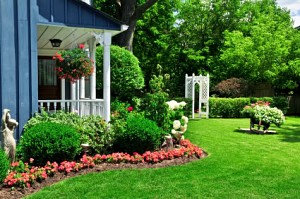DIY Front Yard Design

Does your front lawn look like a postage stamp with a couple of overgrown shrubs around the foundation? If so, add some life to your yard and update your curb appeal by creating a front yard design plan. The goal of every front yard design is the same – to invite and direct homeowners and guests to the front door. Here’s how, even if you don’t know a thing about plants!
Base Plan
One of the biggest mistakes that people make when landscaping is not having a plan. Going to a nursery and looking for plants that are pretty is like choosing a book by its cover at the bookstore. Before you plant anything, you should have a plan that includes a sketch of your property, home and permanent fixtures, and where you would like to create flower beds.
Creating a base front yard design plan is the easiest way to get a handle on the space you are dealing with. Grab a tape measure and measure your yard. On a piece of graph paper, sketch out the yard (one large square=ten feet). Next, measure where your house sits within the yard and its size and sketch it on the paper. Do the same for permanent fixtures like driveways, sidewalks, utility boxes and lamp posts in your yard.
Now take a step back and make some notes about your front yard. Is it in full sun, part shade, full shade? Does it vary throughout the day? Are there overhead wires or underground utilities that need to be taken into consideration? Is the soil wet by the house? All of these considerations will affect plant choice.
Before you start sketching in flower beds and plant choices, make a few copies of your plan. Give yourself room to create, mess up, and redo your front yard design plan. Plant Function
Plants do more for your front yard design than look good. If you are not sure where to place beds for maximum impact, take another look at the front of your house and ask yourself what you need the plants to do. Do foundation plants need to be updated (nothing says last century like a row of manicured shrubs under your front window)? Would you like to soften and extend the corner of your house? Do you want to add focus to a mailbox or lamppost? Would you like to make your lawn less boxy? Do you want to create shade or privacy in the future?
Sketch out the beds on your graph paper. Since sketched to scale and made some plant-pertinent notes, you will now know exactly how big each bed is and what kind of light the area gets.
Beds
- Border Beds: Border beds run along something such as a foundation, driveway or fences. The notion that this is a long, skinny bed is dated. Many border beds offer depth and a free form.
- Corner Beds: A smaller bed used to soften a corner. It’s often seen at the intersection of sidewalk and walkways, or at the corner of a house.
- Island Beds: These are beds that are planned for the middle of yard and are usually used to create visual interest in the middle of a yard. This is a great way to showcase a specimen plant. They can be formal shapes or a freeform design.
- Raised Bed: Raising your garden beds three to five inches from the lawn adds a pop of color (the rich color of mulch), a stage for the plants, better drainage and heap of healthy soil that will help your plants thrive.
- Odd: Do plant in groups of three or odd numbers.
- Layer: Tall plants go in the back, short ones up front and the rest in between. In the case of the island bed, tall plants are in the middle.
- Native: Keep in mind that native plants are most likely to thrive in your garden.
Plant Selection
Now you can start to think about what to fill the beds with to add height, form, texture, color and seasonal interest to your front yard. There are hundreds of foundation, walkway, front door, lamp post and corner front yard design plans on the Internet that can be downloaded. This is a good starting place for ideas. Keep in mind that they will not all be appropriate for every region or yard.
Chances are you don’t know the name of what you want, but you do have an idea of what you want it to look like. Fill a copy of the base plan with general information: Tall, thin evergreen, ornamental grass three to four feet tall, ground cover, etc. Now you can go into a garden center, plan in hand, and say, “I’m looking for a shrub that gets to be four to six feet tall that will work in full sun near the foundation of my home.” Take photos of plants, shrubs, grass and flowers that you like. Most nurseries have knowledgeable staff who will be able to show you what will work in your space, budget and experience level, providing that you have details about where you want a plant to go and what you want it to do. Having a front yard design plan is key to designing a welcoming front yard.
For more information on DIY front yard design, check out this article on landscape design software. Or, for a expert point of view, consult a professional landscaper.
Looking for a Pro? Call us (866) 441-6648

Landscaping Average Costs
Landscapers Experiences

Leaf Removal This Year, More Landscape Work Next Summer

New Low-Maintenance Landscaping To Update Our Yard



